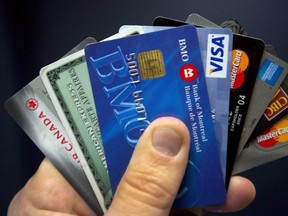Here’s why credit-card cash advances aren’t likely to solve your cash-flow problems

Reviews and recommendations are unbiased and products are independently selected. Postmedia may earn an affiliate commission from purchases made through links on this page.
Article content
Borrowing cash from your credit cards might seem like a good idea when you’re struggling to pay your bills and make ends meet, but before you choose that route to solve a budget deficit or debt problem, think carefully about the implications.
Credit-card debt is expensive enough to deal with, but cash advances come with hefty fees and even higher interest. To help you avoid getting trapped, here’s what you need to know about credit-card cash advances and why it’s worth considering other options first.
Advertisement 2
Article content
Article content
For one thing, the type of transaction that counts as a cash advance has expanded over the years. One of the traditional methods was withdrawing cash directly from your credit card up to your available limit, either at an ATM or through your financial institution.
Credit-card companies also issued “convenience cheques,” so that card holders could write a cheque on their credit card rather than a bank account. As soon as the cheque was negotiated — for instance, to pay rent or another bill — it counted as a cash advance against the credit card.
Now there are a number of additional or hidden ways that a transaction on your credit card will count as a cash advance. For example, a balance transfer — when you use one credit card to pay off another — is a cash advance. If you transfer money online to someone or to your digital wallet from your credit card, that counts as taking cash from your credit card, as does purchasing lottery tickets, certain types of gift cards or if you pay for any gambling charges with your credit card.
Each credit-card provider will have slightly different terms, so check with your provider to know for certain which conditions apply to the cards you use.
Article content
Advertisement 3
Article content
One of the biggest reasons why consumers end up in trouble with cash advances is that, unlike regular credit-card purchases, cash advances don’t have an interest-free grace period.
You typically have a 21-day grace period from the statement date to pay off your balance without incurring interest when you use your credit card for regular transactions. But with cash advances, interest charges immediately start when the money is withdrawn.
To make matters worse, the rate you’re charged is typically steeper than for other credit-card transactions. It’s essential to be aware of this cost before considering a cash advance or transaction covered by the same terms. You can verify the interest rates your credit-card accounts charge by checking your monthly statement.
Keep in mind that you’re essentially borrowing money from your credit-card’s limit when you take a cash advance. It decreases how much available credit you have towards purchases and the cash is like a short-term loan that must be paid back in full, along with interest and fees. Many credit cards also cap the cash advance limit below your overall limit to ensure that accounts stay within their approved limits.
Advertisement 4
Article content
Cash advances are also accompanied by fees. Flat fees can be as much as $5 per cash advance within Canada, and about $7.50 internationally. Some credit-card issuers charge a percentage — say, three per cent to five per cent — of the cash advance amount.
In addition, depending on how you obtain the cash advance, you may also be charged an ATM transaction or cheque-processing fee of a few more dollars. To verify the charges your credit-card issuers charge, it can help to call their customer service department for the most up-to-date terms.
Options around cash advances vary greatly and, depending on your situation, it’s worth exploring alternatives. If you receive a promotional interest rate offer from a new credit card to pay off an existing card, check if you can afford to pay off the full amount of the balance transfer, which is also considered a cash advance, before the low introductory rate expires.
It’s harder to do than most people realize. For example, $10,000 at three per cent interest for the first nine months means making payments of $1,136 each month for nine months before interest and/or fees skyrocket. Most clients are astonished when I outline this because if they could afford payments of $1,100 or more a month, they could pay off their credit cards or save up an emergency fund without much trouble.
Advertisement 5
Article content
Recommended from Editorial
-

Tempted to use a quick fix on your debt? Here are 3 misconceptions
-

Smarter ways to put your tax refund to work
-

Spring forward with this 10-min financial makeover plan
Maxing out cash advance amounts on your credit cards means you won’t have money to pay for regular purchases because payments will be applied to cash advances, interest and fees before they are applied to regular purchases.
Use cash advances sparingly and only for real emergencies, so that you don’t end up buried by credit-card debt. A credit counsellor at a non-profit credit counselling agency in your area can help you explore options to deal with debt and money problems. You should try to find a financial solution that won’t just get you by in the short term, but one that will lead to financial stability in the long run.
Sandra Fry is a Winnipeg-based credit counsellor at Credit Counselling Society, a non-profit organization that has helped Canadians manage debt for more than 27 years.
Bookmark our website and support our journalism: Don’t miss the business news you need to know — add financialpost.com to your bookmarks and sign up for our newsletters here.
Article content




